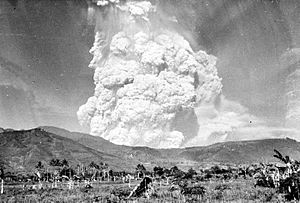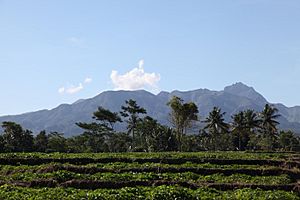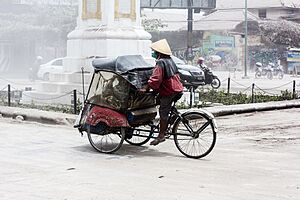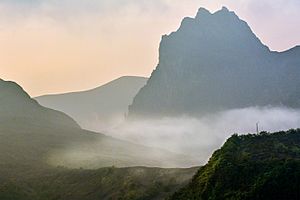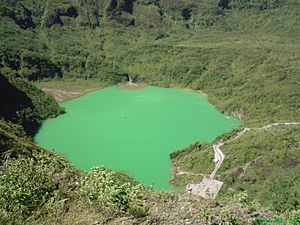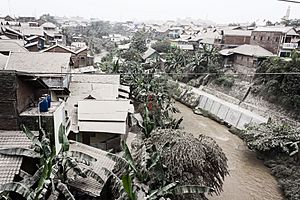Kelud facts for kids
Quick facts for kids Kelud |
|
|---|---|
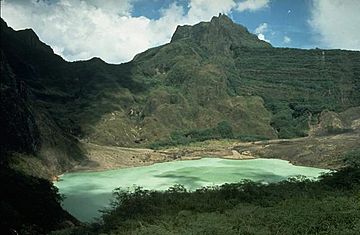 |
|
| Highest point | |
| Elevation | 1,731 m (5,679 ft) |
| Geography | |
| Geology | |
| Mountain type | Stratovolcano |
| Volcanic arc/belt | Sunda Arc |
| Last eruption | February 2014 |
Kelud is an active stratovolcano (a tall, cone-shaped volcano) in East Java, Indonesia. Like many volcanoes around the Pacific Ring of Fire, Kelud is known for its powerful eruptions. More than 30 eruptions have happened since the year 1000 AD. In 2007, a slow eruption created a new lava dome inside its crater. Its most recent eruption was on February 13, 2014. This eruption destroyed the lava dome and shot out rocks, stones, and ash. The ash even reached West Java, about 500 kilometers away!
Contents
Kelud's Eruptions Through History
The 1334 Eruption
The history of Kelud's eruptions is special because some of its activities were written down long ago. In 1334 CE, Mount Kelud erupted. Some religious groups believed this was a sign from the gods. They thought it meant that a god had appeared on Earth as the Javanese king. This shows how people in Java often saw natural events, like volcano eruptions, as messages from the gods.
The 1919 Mudflow
On May 19, 1919, an eruption at Kelud caused hot mudflows, also called "lahars". These lahars killed about 5,000 people. Later eruptions in 1951, 1966, and 1990 caused another 250 deaths. After the 1966 eruption, special tunnels called the Ampera Tunnels were built. These tunnels help to lower the water level in the crater lake. This reduces the danger from lahars.
The 1990 Eruption
In early February 1990, Kelud had a very strong and explosive eruption. It sent a column of tephra (volcanic rock fragments) 7 kilometers high. There was also heavy ashfall and several pyroclastic flows (fast-moving currents of hot gas and volcanic rock). More than thirty people died. Workers kept building the Ampera Tunnel even though the hot pyroclastic flows had buried the tunnel's entrance.
The 2007 Eruption
On October 16, 2007, Indonesian officials told 30,000 people near Kelud to leave their homes. Scientists had put the volcano on the highest alert level. This meant they expected an eruption very soon.
Kelud erupted around 3 p.m. on Saturday, November 3, 2007. The Indonesian government confirmed the eruption. Even though clouds covered the peak, volcanologists (scientists who study volcanoes) knew it was erupting. They saw it on seismic readings, which measure ground shaking.
More than 350,000 people lived within 10 kilometers of the volcano. Surabaya, a big city, is 90 kilometers away. Many people did not leave their homes or came back after being told to evacuate. Some villagers ran away in a panic when they heard about the eruption. But officials later said the eruption that day was not very big. Seismological equipment near the crater was still working. This showed it was a small eruption.
However, early on Sunday, November 4, Mount Kelud shot ash 500 meters into the air. This showed a full eruption was happening. On November 5, new smoke and steam came from the crater. Boiling water flowed down the mountain from the crater lake. The seismic equipment near the crater stopped working. Officials said about 25,000 people were still in the danger zone.
The next day, a lava dome grew in the middle of the crater lake. Cameras showed this 100-meter-long island had risen about 20 meters above the lake's surface. The volcano kept letting out smoke, reaching a kilometer high.
But after two days of smoke and ash, with no lava, officials said on November 8 that a big eruption was not coming soon. They said the volcano was having a "slow eruption." It was not likely to explode like it had many times before.
By November 12, Mount Kelud started to pour lava into its crater lake. The lava dome had grown to 250 meters long and 120 meters high. It cracked open, and lava began to ooze into the water. Smoke rose more than two kilometers high. Ash covered several villages around the volcano. On November 14, smoke went 2.5 kilometers into the air. Light ash covered villages 15 kilometers away. The hot lava dome filled the crater lake, and the lake disappeared.
The 2014 Eruption

Kelud erupted on February 13, 2014. The eruption sent volcanic ash over a huge area, about 500 kilometers wide. Ash fell across much of Java island, from Malang to the west, and also in Central Java and Yogyakarta. About 76,000 people had to leave their homes. Two people died when their houses collapsed from the heavy ash. An older man also died from breathing in the ash. Ash even reached Bandung in western Java by February 14.
The ashfall from this eruption "paralyzed Java." Seven airports had to close. This caused millions of US dollars in financial losses. Many factories and farms were badly affected. Companies had trouble delivering their products. Apple farms in Batu, East Java, lost a lot of money. The dairy industry also had big losses.
On February 14, 2014, major tourist spots in Yogyakarta and Central Java closed. They were covered in ash from the volcano. Workers covered the famous stupas and statues of Borobudur temple to protect them. Many tourists canceled their hotel bookings because of the ash.
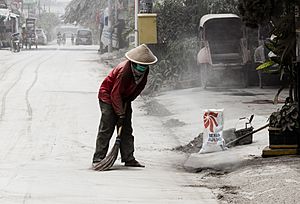
Indonesian military used water cannons to clean roads. They also helped rebuild areas around Kelud. Citizens helped too, with their own equipment. Political groups gave food to people affected by the eruption. By February 20, most businesses and attractions that had closed were open again. Cleaning work was still going on.
The volcano's alert level was lowered on February 21. The danger zone was made smaller, from 10 kilometers to 5 kilometers. By early March, most of the 12,304 buildings that were destroyed or damaged had been fixed. This cost about 55 billion Indonesian Rupiah.
See also
 In Spanish: Kelut para niños
In Spanish: Kelut para niños



